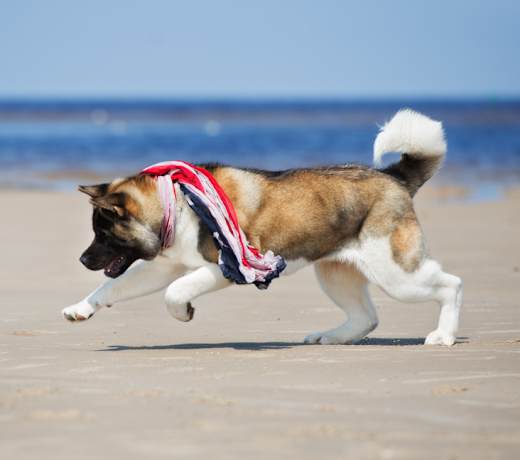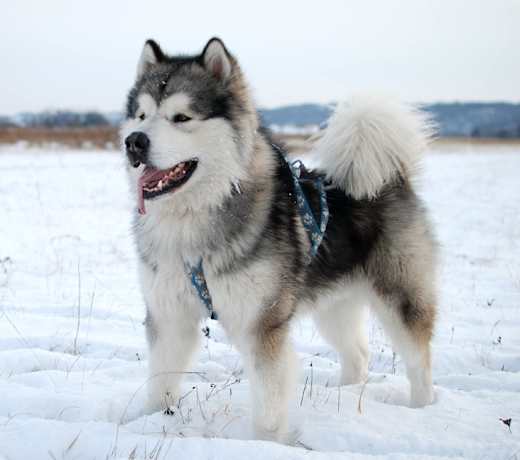Karelian Bear Dogs generally stop growing between 12 and 18 months of age. Most reach their adult height by one year old, but they might continue to fill out and gain muscle mass until around 18 months.
Karelian Bear Dog
Breed Type: Companion
Common nicknames: KBD, Bear Dog
Coat: Double
Hypoallergenic: No, they will likely trigger allergies.
Temperament: Energetic, loyal, protective, independent
Life expectancy: 11-13 years
Color & patterns: Black and white

Weighing in at a sturdy 44 to 50 pounds, the Karelian Bear Dog has a black-and-white coat as rugged as the Nordic wilderness and keen eyes full of adventure and affection. Historically used for hunting large and dangerous game (yes, including bears), this Finnish breed is a daring mix of courage, tenacity, and intelligence. But don’t let their tough exterior fool you: Off-duty, these dogs are sociable, loyal, and loving. So, if you’re looking for a brave and loyal pup, the Karelian Bear Dog could be the perfect match for you.
Karelian Bear Dog characteristics
Learn about about Karelian Bear Dog basics like their fur colors, shedding levels, how much grooming they need, and other Karelian Bear Dog facts.
Average height
19-24 inches (48.3-61.0cm)
Average weight
37-62 pounds (16.8-28.1 kg)
Average lifespan
11-13 years
Exercise needs
Grooming needs
Full-grown size
Good with cats
Good with kids
Training Aptitude
How long do Karelian Bear Dogs live?
Karelian Bear Dogs typically have a lifespan of 11 to 13 years. With proper care, including regular exercise, a healthy diet, and routine veterinary checkups, some might live even longer.
What colors do Karelian Bear Dogs come in?
Karelian Bear Dogs are black and white. Their coats are predominantly black with distinctive white markings on the chest, legs, neck, and face.
How big do Karelian Bear Dogs get?
Karelian Bear Dogs are medium-sized dogs. On average, adult Karelian Bear Dogs are 19 to 23.5 inches tall at the shoulder and weigh 44 to 49 pounds. Males are typically larger and heavier than females.
How much do Karelian Bear Dogs shed?
Karelian Bear Dogs are moderate shedders. Their thick double coat sheds year-round but tends to shed more heavily during seasonal changes, especially in spring and fall when they blow their coat. Regular brushing, about once or twice a week, can help manage the shedding and keep their coat healthy. During shedding seasons, more frequent brushing might be needed.
Do Karelian Bear Dogs get along with other dogs?
Karelian Bear Dogs can be selective about their interactions with other dogs. They might not always get along well with other dogs, especially if they perceive them as a threat or competition. Early socialization is crucial to help them learn to interact positively with other dogs.
With proper introductions and ongoing socialization, many Karelian Bear Dogs can get along with other dogs, particularly if they are raised with them from a young age. However, they might still exhibit some dominant or territorial behavior.
Karelian Bear Dog temperament
Learn about about the Karelian Bear Dog temperament and how well they fit into your lifestyle, home environment, and family.
Are Karelian Bear Dogs good with kids?
Yes, Karelian Bear Dogs can be good with kids, but their behavior largely depends on their individual temperament and early socialization. They are generally loyal and protective, which can make them great companions for families. However, because they are a strong, independent breed with a high prey drive, it’s important to ensure they are well-socialized from an early age and taught how to interact gently with children.
Supervision is key, especially with younger children, to ensure that interactions are positive and that the dog is comfortable. Teaching children how to properly approach and handle dogs is crucial to ensure positive experiences for both the dog and the child, as is teaching dogs how to interact gently with children.
Are Karelian Bear Dogs good with cats?
No, Karelian Bear Dogs are not good with cats in general. Their strong prey drive and instinct to chase can make them prone to viewing smaller animals like cats as something to be pursued. Proper socialization from a young age is crucial if you want to have both a Karelian Bear Dog and a cat in the same household. Even with early socialization, some individual Karelian Bear Dogs might still struggle to live peacefully with cats.
Do Karelian Bear Dogs bark a lot?
Yes, Karelian Bear Dogs bark a lot, especially when they are on alert or feel the need to protect their territory. As a breed developed for hunting large game, such as bears, they use barking to signal their presence and alert their people to potential danger.
While their barking can be beneficial for hunting or protecting their families, it can become excessive if not managed. Early training to control unnecessary barking can help mitigate this behavior.
Is a Karelian Bear Dog a good family dog?
Karelian Bear Dogs can make good family dogs, but they come with some considerations. For example, their high energy levels and strong prey drive mean they require plenty of exercise and mental stimulation. However, they are loyal and protective, which can make them excellent companions.
For families with experience in handling strong, independent breeds, a Karelian Bear Dog can be a great fit. However, the Karelian Bear Dog might not be the best choice for first-time dog parents or families looking for a low-maintenance pet.
Are Karelian Bear Dogs easy to train?
No, Karelian Bear Dogs are not easy to train due to their independent and strong-willed nature. They are intelligent and can learn commands, but their stubbornness and high prey drive can make training a bit more demanding compared to other breeds.
Consistency, patience, and positive reinforcement are key when training a Karelian Bear Dog. They respond well to reward-based training methods and may be more motivated by food or play. Early socialization and obedience training are crucial to manage their natural instincts and ensure they develop into well-behaved companions. However, training any dog takes substantial time and effort, regardless of breed.
How smart are Karelian Bear Dogs?
Karelian Bear Dogs are very smart, especially when it comes to their natural instincts and abilities. They have excellent problem-solving skills and a great ability to perform tasks related to hunting and tracking. Their intelligence is reflected in their capability to learn and execute commands related to these activities.
However, their high intelligence is coupled with a strong independent streak, which can make them seem stubborn or difficult to train at times. They can understand and remember commands but might choose to follow them only when they see the benefit or when properly motivated.
Are Karelian Bear Dogs cuddly?
No, Karelian Bear Dogs are not cuddly dogs. They are more independent and reserved compared to some other breeds. Their primary traits are loyalty, alertness, and a strong sense of duty. They might show affection in their own way, such as sitting close to you or leaning against you, but they usually do not seek out or enjoy constant physical contact as some more affectionate breeds do.
Are Karelian Bear Dogs friendly?
Karelian Bear Dogs can be friendly, but their friendliness often depends on their socialization and individual temperament. They are loyal and affectionate with their families and can be quite warm and engaging with other people they know and trust. However, they are naturally reserved or cautious around strangers. They are also known for their protective nature, which can make them more aloof or guarded in unfamiliar situations.
Proper socialization and positive experiences with various people and situations can help them become more approachable and confident.
Karelian Bear Dog history
Learn about where the Karelian Bear Dog came from.
Where are Karelian Bear Dogs from?
Karelian Bear Dogs are from Finland. They were traditionally bred for hunting large game, such as bears, moose, and wild boar. The breed comes from the Karelia region, which spans parts of Finland and Russia, and they have been used for centuries by Finnish and Karelian hunters due to their bravery, strength, and strong hunting instincts. They are especially known for their ability to stand up to large animals and are still used today in wildlife management, particularly for bear control.
How many types of Karelian Bear Dogs are there?
There is only one recognized type of Karelian Bear Dog, which originates from Finland. The breed is sometimes compared to other similar northern or spitz-type hunting dogs, such as the Russian-European Laika, which shares some characteristics. Despite these comparisons, the Karelian Bear Dog remains a distinct breed with its own specific traits.
Are Karelian bear dogs rare?
Yes, Karelian Bear Dogs are rare, particularly outside of Finland. In their native country, they are more common but still not as widespread as other breeds. Their specialized skills as hunting dogs for large game and their specific temperament limit their appeal to a broader pet-owning population, which contributes to their rarity.
Karelian Bear Dog health
Learn about about the Karelian Bear Dog health outlook and what diseases they may be prone to at various stages of their life.
Do Karelian Bear Dogs have health issues?
Karelian Bear Dogs are generally a healthy breed, but like all dogs, they are prone to certain health issues. Some common health issues for Karelian Bear Dogs include:
Hip dysplasia: A genetic condition where the hip joint doesn’t fit into the hip socket properly, which can lead to arthritis and pain.
Elbow dysplasia: Similar to hip dysplasia, this condition affects the elbow joint and can lead to lameness and arthritis.
Thyroid issues: Some Karelian Bear Dogs are prone to thyroid disorders, which can affect their metabolism and overall health.
Eye problems: Some Karelian Bear Dogs can develop conditions such as cataracts or progressive retinal atrophy (PRA).
Are Karelian Bear Dogs hypoallergenic?
No, Karelian Bear Dogs are not hypoallergenic. Their thick double coat sheds and releases dander, a common allergen. While no dog breed is completely hypoallergenic, some breeds produce fewer allergens than others, but the Karelian Bear Dog is not one of them.
Find Karelian Bear Dog puppies near you
Adopting a Karelian Bear Dog
We don't see any Karelian Bear Dogs available for adoption in your exact location or cities near you, but here are some adorable similar breeds in Beverly Hills, CA.

Hatchi
Akita Siberian Husky
Male, 2 yrs 6 mos
Los Angeles, CA
Good with dogs
Not good with cats
Needs special attention
Needs experienced adopter
House-trained
Spayed or Neutered
Shots are up-to-date

Baloo
Chow Chow
Male, 7 yrs 4 mos
Los Angeles, CA
Good with dogs
House-trained
Spayed or Neutered
Shots are up-to-date

Luca
Chow Chow
Male, adult
Los Angeles, CA
Good with dogs
Not good with cats
Needs experienced adopter
House-trained
Spayed or Neutered
Shots are up-to-date

ECHELON
Akita
Male, 8 yrs 2 mos
Burbank, CA

*TONGA
Akita
Male, 2 yrs
Burbank, CA

BEAR
Akita
Male, 1 yr 8 mos
Burbank, CA

Smokey
Chow Chow
Male, 6 yrs 4 mos
Marina del Rey, CA
Needs experienced adopter
House-trained
Spayed or Neutered
Shots are up-to-date

Kalyria
Chow Chow
Female, young
Marina del Rey, CA
Shots are up-to-date

Hatchi
Akita Siberian Husky
Male, 2 yrs 6 mos
Los Angeles, CA
Good with dogs
Not good with cats
Needs special attention
Needs experienced adopter
House-trained
Spayed or Neutered
Shots are up-to-date

Baloo
Chow Chow
Male, 7 yrs 4 mos
Los Angeles, CA
Good with dogs
House-trained
Spayed or Neutered
Shots are up-to-date

Luca
Chow Chow
Male, adult
Los Angeles, CA
Good with dogs
Not good with cats
Needs experienced adopter
House-trained
Spayed or Neutered
Shots are up-to-date

ECHELON
Akita
Male, 8 yrs 2 mos
Burbank, CA

*TONGA
Akita
Male, 2 yrs
Burbank, CA

BEAR
Akita
Male, 1 yr 8 mos
Burbank, CA



